Malaria may be the worst killer in history. It still kills thousands of people — mostly children — every year.
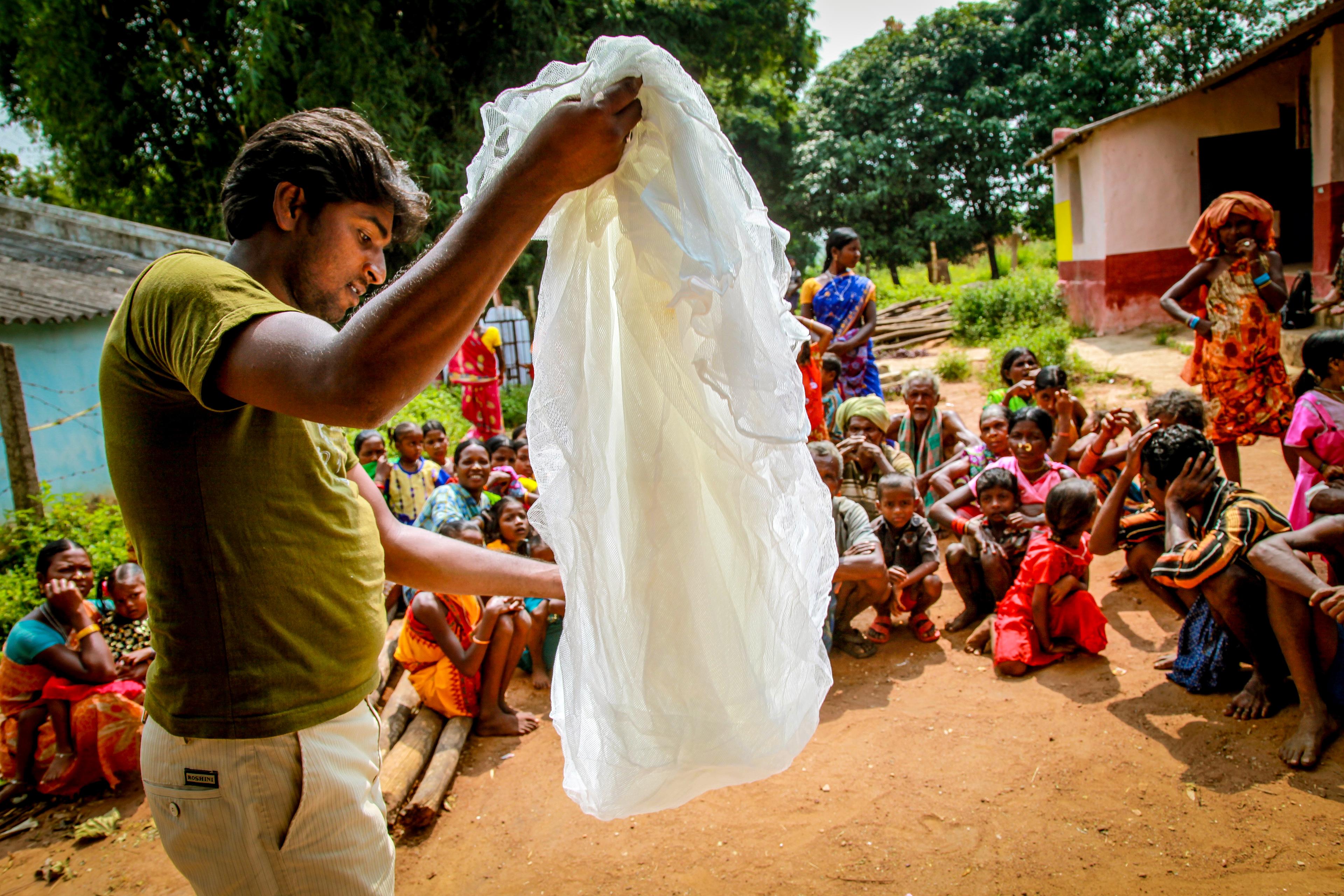
An SOVA volunteer working with AMF gives a tutorial on how to effectively hang a mosquito net in Orissa, India (AMF / againstmalaria.org)
The World Health Organisation estimates1 that in 2015 alone, 438,000 people died of malaria - 292,000 of whom were children under 5 in sub-Saharan Africa.
But this map shows a surprising, and encouraging result.
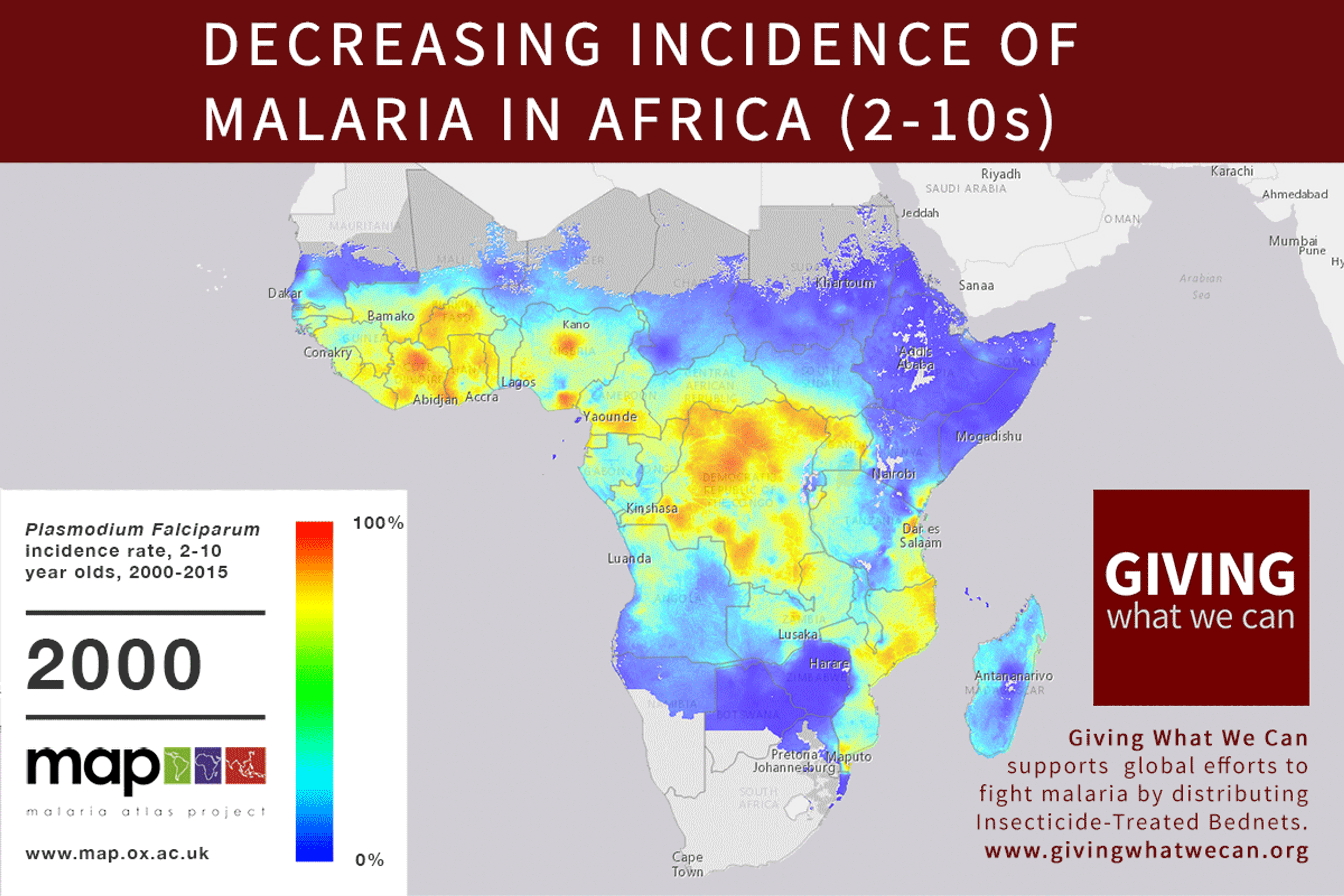
The animation shows the percentage of children in Africa who had malarial fevers over the last 15 years. Dark red means 100% -- that is, all children in the area -- had at least one episode of clinical malaria within a given year. Green means 50%, and blue means that no children had a malaria fever within a given year.
Here’s another map using data for people of all ages2 — you can see the same pattern. A massive decrease in malaria cases over the last 15 years.
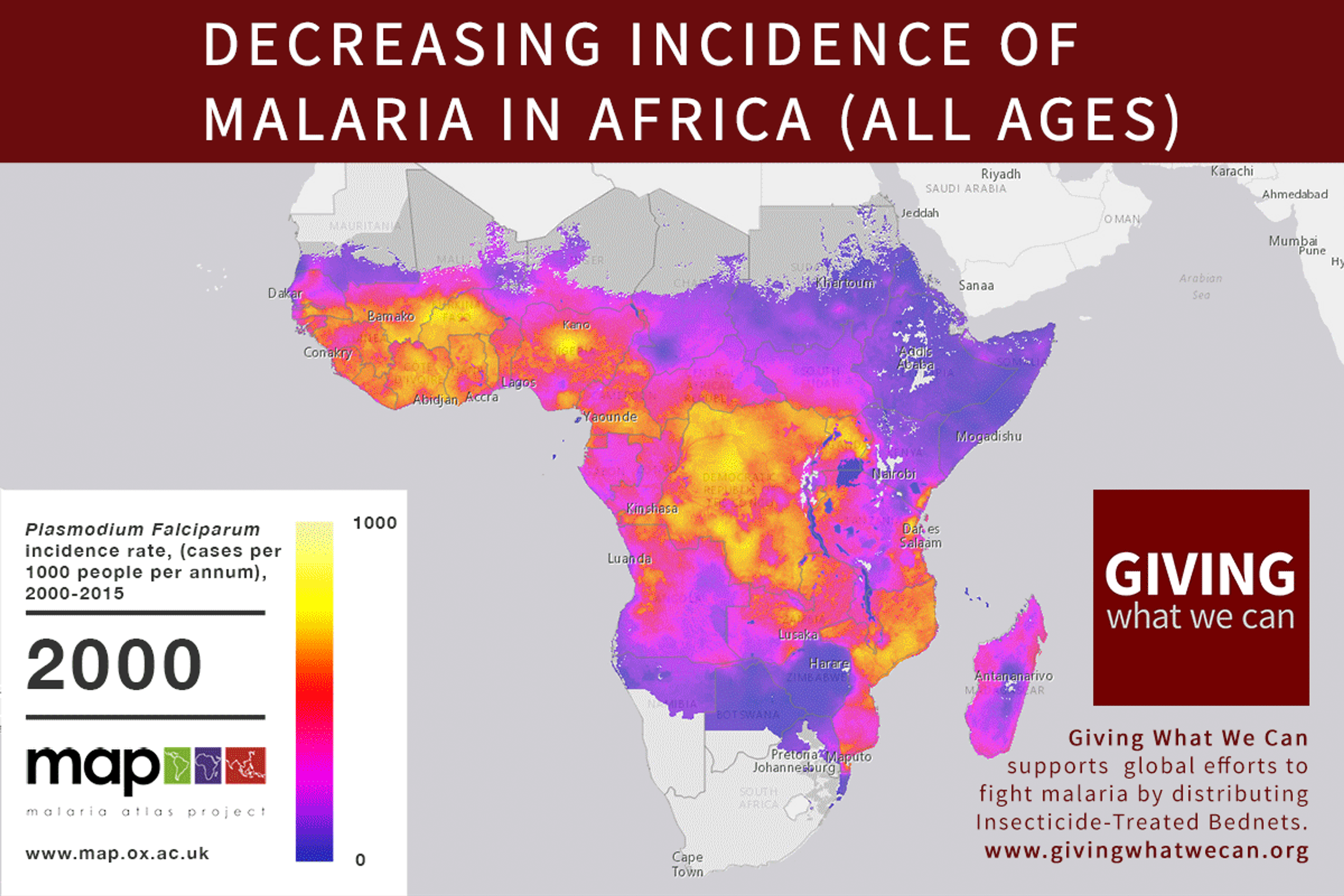
These maps show a clear trend — in fact, rates of malaria have halved over the past 15 years3. But why has there been such a dramatic decrease in malaria?
The next animation has the answer:
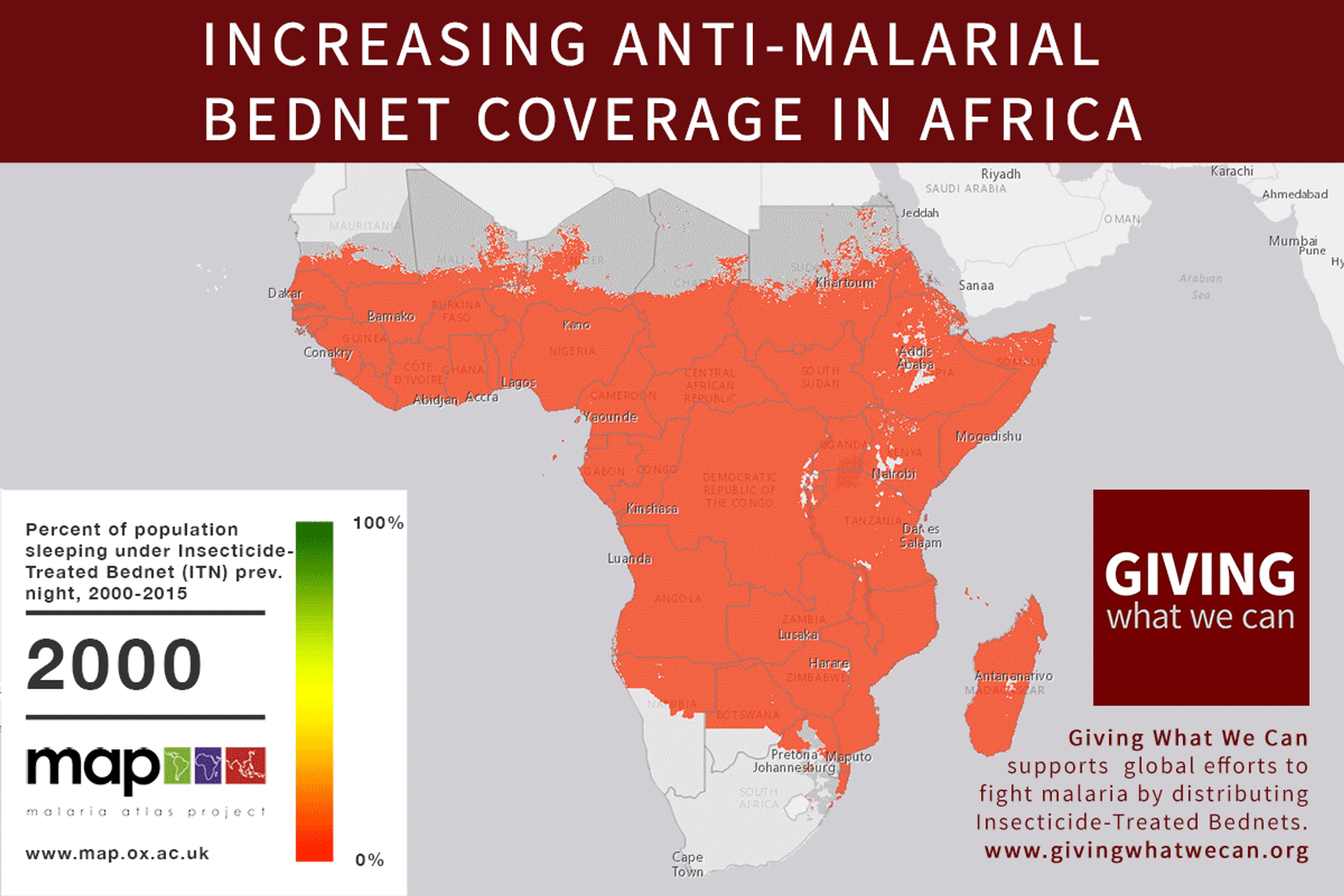
The reduction in malaria has been caused — in large part — by people sleeping under bednets. Green means everyone is sleeping under bednets and is protected, yellow means half of all people are protected, and red means nobody is protected from malaria.
Long lasting insecticide-treated bednets are a powerful weapon against malaria, not only because they’re a physical barrier between mosquitoes and sleeping children — the insecticide coating kills mosquitoes, so they don’t infect other members of the family (and the village) who don’t have mosquito nets.
The data used for these animations comes from a new paper published in Nature 3 (widely regarded as the top science journal). We already had very strong evidence that bednets prevent children from dying of malaria (and related complications like anemia) based on a meta-analysis of 22 experimental trials4.
But this new paper uses a “spatiotemporal Bayesian geostatistical model of bednet coverage with 27,573 georeferenced population clusters and an optimised suite of temporally dynamic environmental and sociodemographic covariates”.
In other words, this paper tells us about the bigger picture, showing that bednets are incredibly effective, not just at the level of individual villages, but at the level of whole populations. Essentially, the case that we should be distributing bednets just got even stronger.
Women and children carrying insecticide-treaded mosquito nets distributed by the Against Malaria Foundation in Ntcheu, Malawi
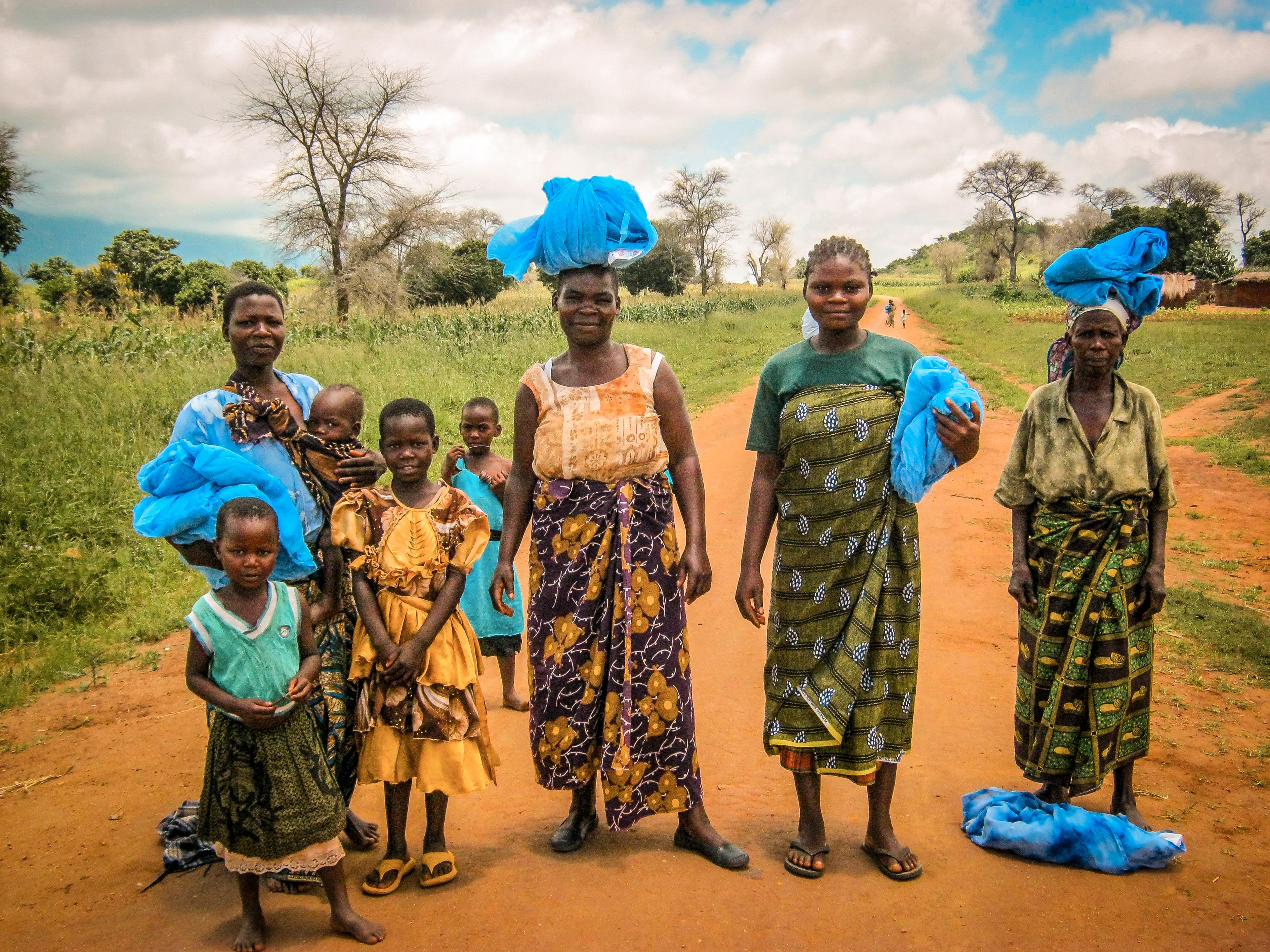
The research suggests that anti-malarial interventions have prevented about 663 million malarial fevers. Long-lasting insecticide treated bed nets stand out as being particularly effective — being responsible for around 68% of the malaria reduction. This means that bednets have prevented around 450 million cases of malaria! And globally, 6.2 million fewer people died of malaria over the last 15 years because of malaria interventions 1.
We’ve made great progress. But we’re only halfway there.
Notice that, even in 2015, there are red and yellow spots on the map. 45% of all people in Africa are still at risk of disease and death from malaria 1, because they are too poor to buy nets, and an additional 245 million nets are needed in the next 2 years.
Blood smear showing Plasmodium Falciparum, the parasite which causes malaria (commons.wikimedia.org)

Malaria is also an immense economic burden on health systems and people: since 2000, malaria treatment in sub-Saharan Africa has cost almost $300 million1. We can see the flip side of this in places in the United States, Brazil and Uganda — children born after malaria was eradicated or heavily controlled and so were not exposed to malaria during pregnancy, had substantially higher income later in life 5,6.
We urgently need to keep funding the distribution of bednets, because bednet distributions are one of the most cost-effective ways of preventing disease and death. Since 2000, one billion bednets have been distributed (costing around 5 dollars each), and have averted 450 million cases of malaria — this suggests that, on average, one episode of clinical malaria can be prevented for about $11 (malarial fevers can be very painful. One recent study suggests that in Kenya, bednet distributions between 2003 and 2008 have prevented a death of a child for about $1,011 on average7.
The charity evaluator Givewell estimates that the cost per child death averted through bed net distributions funded by the Against Malaria Foundation is now about $2,8388 (even though these estimates are uncertain, they're roughly comparable to the new malaria vaccine, which is not 100% effective and experts say should be used in combination with bednets9).
Both our colleagues at Givewell10, and we at Giving What We Can, rank the Against Malaria Foundation as our number 1 top charity this year. This is not only because we think it is the most cost-effective charity one can donate to, but also because of Against Malaria Foundation’s outstanding transparency and accountability.
For instance, on their website you can see video footage from distributions, as well as detailed financial statements. They also check if the nets they distributed are still hung every 6 months in a random sample of 5% the households (two years after distribution, 81% of nets distributed were still being hung up and the most comprehensive study suggests that bednets are almost never used for things like fishing11. And while we're dispelling myths: preventing deaths will not lead to overpopulation).
We can all help to make the maps above more blue and green. The Against Malaria Foundation needs a minimum of $13.4 million to fill their funding gap next year 12, so consider making a donation to AMF today. And if you want to keep up the fight long-term, why not join us, and more than 1400 people — among them development economists, moral philosophers, students, nurses, entrepreneurs, scientists and teachers — and take the Giving What We Can pledge to give 10% of your income to the charities that you think are most effective (or just 1% for those who don’t work full time).
We’re winning some impressive battles against one of history’s biggest killers. As more people start donating to a cause that is rigorously evidence-based and extremely cost-effective, we can start to win the war.